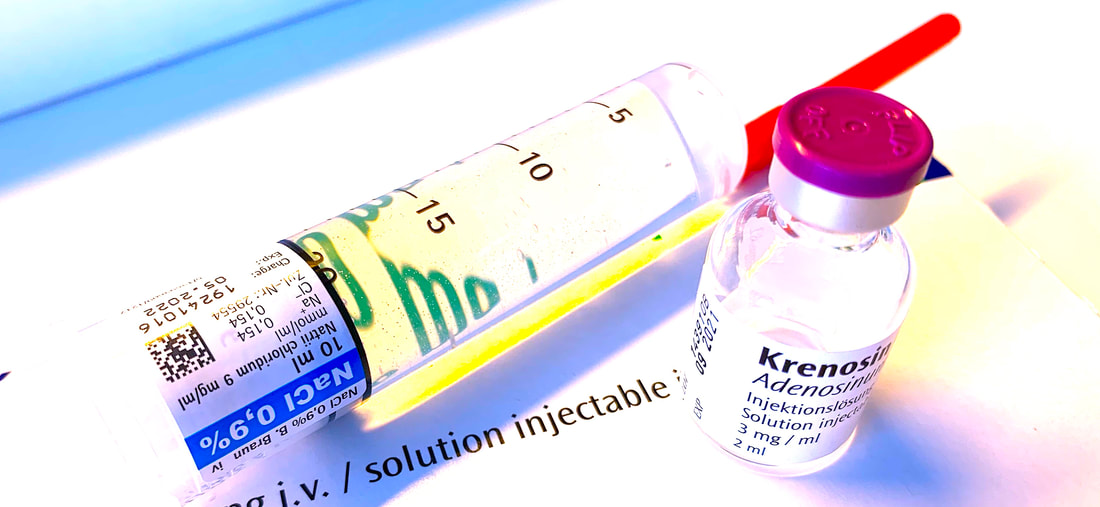 Supraventricular tachycardias (SVT) typically refer to tachydysrhythmia arising from above the level of the bundle of His and usually present as a small complex tachycardia. A classification based upon a narrow QRS-complex is useless though as this is also dependent on any pre-existing bundle branch block. SVT's can be classified a follows Regular Atrial Sinus tachycardia Atrial tachycardia Atrial flutter Inappropriate sinus tachycardia SNRT Irregular Atrial Atrial fibrillation Atrial flutter with variable block Multifocal atrial tachycardia (MAT) Regular Atrioventricular AVRT AVNRT Automatic junctional tachycardia AV nodal re-entry tachycardia (AVNRT) is the most common cause of palpitations in patients with structurally normal hearts and mostly occurs spontaneously or triggered (e.g. exercise, caffeine etc.) Although usually well tolerated, SVT's can become a potentially life-threatening condition. Treatment with Adenosine The American Heart Association 2015 guidelines for Adult Advanced Cardiac Life Support recommends adenosine in non-hypotensive patients with regular narrow complex SVT. Adenosine is an endogenous purine nucleoside that blocks atrioventricular nodal conduction via the A1 receptors in the cardiac tissue. That is why the use of adenosine causes transient asystole, which in turn very often produces a sense of 'impending doom' or a feel that one is about to die. With a half-life less than 10 seconds, cardioversion can be performed quickly, and side effects usually are limited and short-lasting. Due to these kinetics, 6 mg of adenosine are classically administered as a rapid intravenous bolus followed by a 20ml saline flush. If the first dose fails to restore normal sinus rhythm, another 12 mg of adenosine are recommended. This can be repeated one more time if necessary. As adenosine and normal saline are mostly applied over a 2-way stop-cock, this procedure might result in a suboptimal application for technical reasons.  Did you know: If adenosine is given over a central line, its dose should be halved! The Single Syringe Adenosine-Trial Wouldn't it be great, to simply mix your adenosine into the syringe with the saline flush and administer the 'cocktail' as one? Well, this is exactly what Marc McDowell at al. did. They performed a small prospective study of 53 hemodynamically stable adults who presented to a single emergency department with SVT patients were given 6 mg of adenosine one of two ways: in a single syringe combined with 18 mL of saline (26 patients) or in two separate syringes, one containing adenosine and the other 20 mL of saline (27 patients) They found: More patients in the single-syringe group than the two-syringe group converted to sinus rhythm after the first dose (73.1% vs. 40.7%) By the way: This is not the first study looking into mixinf adenosine with normal saline. Choi et al. have already mixed 6mg of adenosine with 15ml of normal saline and found a comparable conversion rate compared to the 'conventional' method. Although both studies show several limitations, there are some important information we can get:
- Concern that diluting adenosine into normal saline maight impair the drug's efficacy is not justified - Administering adenosine and normal saline in one syringe is safe and at least equaly effective - This 'Single Syringe'-technique ist technically safer and should be considered in this setting I personally will will be going down this path from now on. McDowell M, Mokszycki R, Greenberg A, et al. Single Syringe Administration of Diluted Adenosine. Acad Emerg Med. 2019 Oct 30. Choi SC, Yoon SK, Kim GW, et al. A convenient method of adenosine administration for paroxysmal supraventricular tachycardia. J Korean Soc Emerg Med 2003;14(3):224-7. Comments are closed.
|
Search
|



 RSS Feed
RSS Feed


